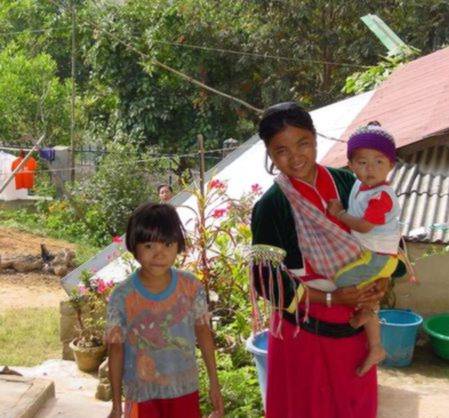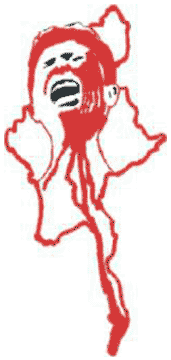Suffering in Shan State
|
||||||||||
| Shan State is the largest of the seven ethnic states in Burma, with a population of about eight million. Half are ethnic Shan, a sophisticated ethic group with ties to Tai in China and Thai in Thailand. Other groups living in Shan State are Burman, Lahu, Akha, Palaung, Lisu, Kachin, and Pa'O. |
||||||||||
|
The past several years have seen a profound deterioration in the human rights situation throughout central Shan state. Since 1996, about 2,000 full-fledged towns and villages have been relocated, driving half a million people out of their homes and pushing well over 100,000 Shan into Thailand. Refugees fleeing from the war tell stories of torture, rape, and summary execution–atrocities that, in Eastern Europe, might have captured headlines and triggered international action on behalf of vulnerable civilians persecuted by a vicious army bent on ethnic cleansing, intent on genocide. There was little notice, however, because these events took place in an obscure Asian civil war zone, closed off to journalists. Amnesty International and Human Rights Watch have recorded the usual pattern in relocations: typically people were given a couple of days in which to move; after the deadline passed, everything was burned, with some reports of people trapped and burned to death in their homes. Afterwards, even though some villagers might have been given written permission to return to their fields to cultivate or harvest rice, they were still liable to arrest and even execution for entering a free-fire zone. |
 Shan family arriving at a clinic established for refugees in Thailand near the border |
|||||||||
|
Recently, SPDC (State peace and Development Council), Burma's military junta, has worsened the situation by moving Wa villagers from their traditional homeland near the Chinese border and relocating them to areas previously occupied by Shan in Southern Shan State. The Wa, once notorious for their practice of inter-clan head-hunting, were controlled and used for years by the now defunct Communist Party of Burma as foot soldiers, which resulted in a high number of widows and orphans. With no medical system, the infant mortality is estimated at 50%. Only 3% of the population can read and write. Since the end of 1999, over one quarter of the entire Wa population has been forcibly resettled. The SPDC has claimed that the mass Wa resettlement program is aimed at improving their living conditions and the eradication of opium production, but there is abundant evidence that the resettled Wa are planting new opium fields, with the support of SPDC officials. Furthermore, the change in altitude between their mountain homeland and the Shan Plateau has meant serious outbreaks of diseases such as malaria. Certainly the relocation follows the pattern of SPDC's divide-and-rule strategy: pitting the Wa against the Shan resistance and using the Wa as a proxy army. Conflicts between the Wa and Shan have indeed increased the flow of Shan refugees into Thailand. At one checkpoint, there are at least 1000 refugees crossing into Thailand every month. The Shan have been fleeing from the counter-insurgency activities of the Burmese army to Thailand in large numbers since the early 1990s. However, unlike the Karen, the Karenni, and the Mon, the Shan have never been permitted by the Thai authorities to establish camps as displaced persons. Denied protection in Thailand, they have had to seek dangerous and dirty work in agriculture and construction, where as undocumented workers, they are liable to exploitation and arrest. The economic crisis Thailand has faced since mid-1997 has meant that thousands of Shan migrants have lost what little security their marginal jobs offered. At the same time, most of these people have no homes to return to in Shan state. Some of the refugees we met had been forcibly relocated more than once by the Tatmadaw (Burmese army), and the process was invariably accompanied by human rights violations. The Burmese army never provides relocated villagers with shelter, water, sanitation, or food at their new site. Relocated civilians are placed in a Catch-22 situation: they are denied the means to survive in their relocation center, but if they dare to return to their old villages to retrieve food, they risk being shot by the army. One monk quietly described returning, with great difficulty, to the site of his home village, only to find everything, including the monastery where he had ordained, burned to the ground. Nothing in the village, remained–no rice barns, no houses, no livestock, not even a dog. The trees in the orchards had also been cut down. Later, he was able to find some neighbors who told him that his parents were still alive, but he was unable to find them. In Piang Luang, a village north of Chiang Mai, situated right on the border, about 500 refugees from two Shan villages were allowed to set up a makeshift camp with bamboo and plastic sheeting in the compound of a monastery in May 2002. When we visited in January 2003, more than 300 people were still there. The headman told us that, as they were fleeing, two young men of their group had been unlucky enough to be accosted at gun-point by Burmese soldiers who demanded money. Although the men swore they had nothing to give and begged for their lives, they were shot dead at point-blank range. Several men have sneaked back across the border to the sites of their old villages, only to find everything destroyed by the Burmese army. |
||||||||||
|
The abbot of the monastery assured us that he would allow the refugees to stay there as long as possible, although there were rumors of Thai plans to push the refugees back over the border as early as March or April. We made a small donation to help with the expenses for water and electricity, which are putting a strain on the monastery. It has taken tremendous courage to document and publicize the ongoing persecution of Shan civilians. Fortunately, there is no lack of steadfastness in Shan Women's Action Network (SWAN), Shan Human Rights Foundation, and other Shan activists. |
|||||||||
|
SWAN gained international prominence last year with the release of the shocking report, "License to Rape," documenting the use of rape by Burmese soldiers as military strategy. The repercussions have forced SWAN to adopt a low profile. These are dark days for the Burmese democracy movement in Thailand, not only for the Shan, but for all activists. At the end of 2002, the Thai Government closed the offices of all opposition groups in Mae Hong Son, Sangkhlaburi, and Mae Sot, sending democracy activists undercover. In Sangkhlaburi, even the pregnant wives of some dissidents had to hide in the jungle to escape being rounded up by Thai authorities. The administration of Prime Minister Thaksin Shinawatra, in its attempts to curry favor with the Burmese dictatorship and to win lu crative business contracts, has cracked down on organizations opposed to the junta, including those carrying out humanitarian relief efforts and crucial information-gathering activities. ] |
||||||||||
|
|
||||||||||

